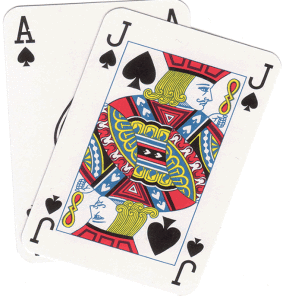How to Play Blackjack

Daddy Fat Stacks has developed advanced Blackjack strategy courses that teach valuable money making betting systems. The current courses include the Golden Eagle Blackjack Strategy and the Silver Tiger Blackjack Strategy. Try Daddy Fat Stacks’s advanced strategies out now, so you can be the next big blackjack winner at your favorite casino. Daddy Fat Stacks has been selling blackjack strategies for over 30 years and is the most trusted name in the industry. Learn from our advanced courses today and profit from our strategies tomorrow. Win big the next time you visit the casino with our advanced blackjack strategies.
Advanced Blackjack Strategies
Golden Eagle Blackjack Strategy
Silver Tiger Blackjack Strategy
How to Play Blackjack
Available in every casino and played at home by fans around the globe, blackjack has been around since the 1600s and is a spinoff of a popular game of unknown origins. The object of the game is incredibly simple. This comparing card game is played between up to seven people and a single dealer, where the object is to beat the dealer without exceeding a numeric count of twenty-one.
Players are dealt a two-card hand, where the numeric value of the cards are added together. From there, each participant has a few separate options on how to proceed, which will be discussed in detail below.
Hit
A hit is a signal from the player(s) to the dealer that he or she wishes to receive another card after the initial two are dealt, with the aim of drawing closer to twenty-one without going over (which is called a bust). The actual signal for a participant to receive a hit is different depending on the venue, with some casinos allowing for verbal signals, and others requiring certain hand motions. Though saying “hit me” is the most commonly accepted way to signal.
Stand
When a blackjack player stands, this is a signal to the dealer that he or she is happy with the hand they were dealt. Players are able to stand at any time in the hand. If, for example, you are happy with the two initial hole cards and their numeric value, you may stand. Likewise, you may stand after receiving one or any number of hits. This signals to the dealer to stop hitting, and is usually performed by holding a flat palm over the cards. “Stay” is a term used that acts the same as standing.
Double Down
A double down in blackjack is where players elect to double their initial bets while receiving one more card. For example, if a participant is dealt a hand he or she is happy with, and sees that the dealer’s hand is weak, the player may call for a double down in the expectation of doubling the amount won. At most casinos, double downs require players to put forth the equal amount of chips after the deal to signal the move, while also turning both cards face-up.
Insurance
Insurance in blackjack is a move that protects players against a potential blackjack from the dealer. For instance, if the dealer is showing an ace as their up card, there is a higher probability that the hand will be a natural twenty-one. For half the amount of the original bet, the player can take blackjack insurance and break even on the hand if the dealer has a blackjack.
Blackjack Rules
Even those relatively unfamiliar with blackjack are often able to grasp the gist of the game in a colloquial sense; i.e. twenty-one or closest winning. Though while the game seems incredibly simple, blackjack is actually very nuanced and deals with quite a few rules.
Blackjack is played with a standard 52-card deck, but casinos often implement a shoe, which is a mechanism designed to hold multiple decks of cards. In some shoes, participants may be playing twenty-one with upwards of eight decks of cards (typically four or six). This is a countermeasure to stave off card counters and to ensure that the house always retains the edge.
The game begins with players pushing forth their initial bets to initiate the deal. In games involving a shoe (multi-deck) the cards are dealt face-up for everyone. In games with only single or double decks, the participants cards are dealt facing down with the dealer’s hand having one down card and one up card.
Each card is assigned its own point value. Cards 2-9 are worth their face value, as well as all four 10 cards in a single deck, though the Jack, Queen and King are also worth the numeric value of 10. Aces are worth 1l or 1, depending on where a player is at in his or her hand. For example, if a player accepts a hit when they have a numeric value of 16 (e.g. a 9h, 7c) and receives an ace, this card will only count as 1, equaling the numeric value of 17. Conversely, if the player receives an ace and a card with the value of 10, that ace then counts as 11 and gives a natural twenty-one.
The best possible hand in blackjack is its namesake: Blackjack. This happens with any ace and any card with the numeric value of 10. Getting this hand as a player typically pays out 3:2, and a dealer receiving this hand is an instant win, unless the player is able to match. If multiple parties have twenty-one after the initial two-card deal, the bet is a push, meaning the money is returned. If the player receives blackjack, the dealer is allowed up to three more cards to match twenty-one for a push.
Dealer rules do vary from casino to casino, but the most common rule for dealers is that they stay (stand) their hands at a numeric value of 17, while having to draw until reaching the value of 16. Beyond the dealer, games of twenty-one typically involve four to seven additional players at the table, though they can be played in one-on-one fashion pitting a single participant against a dealer.
Quick tip: Always check the specific rules of the location you’re playing at. Though some rules are universal, others are venue-specific and may catch you off guard.
House Edge and Blackjack Payouts
The edge the house maintains in blackjack is always present, but the actual numeric value of the advantage changes based on different variables. For instance, if the dealer must stay on a soft 17, this increases the house edge by around 0.2%. Though it doesn’t seem like much, this is actually a big number, as the house takes on a multitude of players in a high number of hands.
Other factors affecting the house edge include the amount of decks used in the game. In games of twenty-one involving a single deck, the player’s advantage is greater than games involving multiple decks. Here is a list of the typical house advantage based on number of decks:
- 8 decks: 0.65% advantage
- 6 decks: 0.64% advantage
- 4 decks: 0.60% advantage
- 2 decks: 0.46% advantage
- 1 deck: 0.17% advantage
Blackjack payouts should be understood for the player’s benefit. For instance, earning a blackjack on the initial two cards, known as a natural twenty-one, pays out 3:2. This means one a half times the initial bet. So a $10 bet would pay out $15 profit on top the initial bet.
Insurance bets, as discussed previously, allow you to break even when the dealer has a natural twenty-one. However, this insurance bet is lost if the dealer does have blackjack. Though since insurance is only half of the bet total, the player retains half the bet.
There are other variations and terms blackjack players should familiarize themselves with, such as different rules of doubling down, splitting same-card hands, and any other venue-specific house rules of the game in question. Though after reading this guide, you should have a good understanding of blackjack and how to play the game.
Free Optimal Blackjack Strategy Plus Bonus Guide
History of Blackjack


